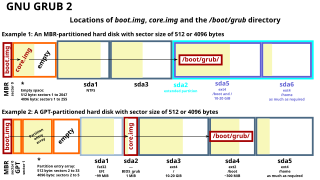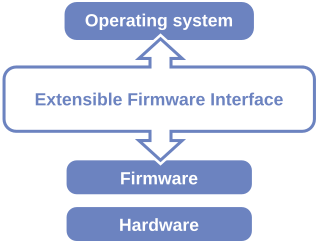Related Research Articles

In computing, BIOS is firmware used to perform hardware initialization during the booting process, and to provide runtime services for operating systems and programs. The BIOS firmware comes pre-installed on a personal computer's system board, and it is the first software to run when powered on. The name originates from the Basic Input/Output System used in the CP/M operating system in 1975. The BIOS originally proprietary to the IBM PC has been reverse engineered by some companies looking to create compatible systems. The interface of that original system serves as a de facto standard.

In computing, booting is the process of starting a computer. It can be initiated by hardware such as a button press, or by a software command. After it is switched on, a computer's central processing unit (CPU) has no software in its main memory, so some process must load software into memory before it can be executed. This may be done by hardware or firmware in the CPU, or by a separate processor in the computer system.
VESA BIOS Extensions (VBE) is a VESA standard, currently at version 3, that defines the interface that can be used by software to access compliant video boards at high resolutions and bit depths. This is opposed to the "traditional" int 10h BIOS calls, which are limited to resolutions of 640×480 pixels with 16 color (4-bit) depth or less. VBE is made available through the video card's BIOS, which installs during boot up some interrupt vectors that point to itself.
x86 assembly language is a family of backward-compatible assembly languages, which provide some level of compatibility all the way back to the Intel 8008 introduced in April 1972. x86 assembly languages are used to produce object code for the x86 class of processors. Like all assembly languages, it uses short mnemonics to represent the fundamental instructions that the CPU in a computer can understand and follow. Compilers sometimes produce assembly code as an intermediate step when translating a high level program into machine code. Regarded as a programming language, assembly coding is machine-specific and low level. Assembly languages are more typically used for detailed and time critical applications such as small real-time embedded systems or operating system kernels and device drivers.

A boot sector is the sector of a persistent data storage device which contains machine code to be loaded into random-access memory (RAM) and then executed by a computer system's built-in firmware.

The A20, or address line 20, is one of the electrical lines that make up the system bus of an x86-based computer system. The A20 line in particular is used to transmit the 21st bit on the address bus.
Logical block addressing (LBA) is a common scheme used for specifying the location of blocks of data stored on computer storage devices, generally secondary storage systems such as hard disk drives. LBA is a particularly simple linear addressing scheme; blocks are located by an integer index, with the first block being LBA 0, the second LBA 1, and so on.

In DOS memory management, the high memory area (HMA) is the RAM area consisting of the first 65520 bytes above the one megabyte in an IBM AT or compatible computer.
In the 80386 microprocessor and later, virtual 8086 mode allows the execution of real mode applications that are incapable of running directly in protected mode while the processor is running a protected mode operating system. It is a hardware virtualization technique that allowed multiple 8086 processors to be emulated by the 386 chip; it emerged from the painful experiences with the 80286 protected mode, which by itself was not suitable to run concurrent real mode applications well.

The Unified Extensible Firmware Interface (UEFI) is a specification that defines a software interface between an operating system and platform firmware. UEFI replaces the legacy Basic Input/Output System (BIOS) firmware interface originally present in all IBM PC-compatible personal computers, with most UEFI firmware implementations providing support for legacy BIOS services. UEFI can support remote diagnostics and repair of computers, even with no operating system installed.
The Program Segment Prefix (PSP) is a data structure used in DOS systems to store the state of a program. It resembles the Zero Page in the CP/M operating system. The PSP has the following structure:
BIOS interrupt calls are a facility that operating systems and application programs use to invoke the facilities of the Basic Input/Output System software on IBM PC compatible computers. Traditionally, BIOS calls are mainly used by DOS programs and some other software such as boot loaders. BIOS runs in the real address mode of the x86 CPU, so programs that call BIOS either must also run in real mode or must switch from protected mode to real mode before calling BIOS and then switching back again. For this reason, modern operating systems that use the CPU in Protected mode or Long mode generally do not use the BIOS interrupt calls to support system functions, although they use the BIOS interrupt calls to probe and initialize hardware during booting. Real mode has the 1MB memory limitation, modern boot loaders use the unreal mode or protected mode to access up to 4GB memory.
An Option ROM is a piece of firmware that resides in BIOS or on an expansion card, which gets shadowed into memory and executed to initialise the device and register it with the BIOS. It is essentially a driver that interfaces between BIOS services and hardware.
In computer science, a memory map is a structure of data that indicates how memory is laid out. The term "memory map" can have different meanings in different contexts.
INT 13h is shorthand for BIOS interrupt call 13hex, the 20th interrupt vector in an x86-based computer system. The BIOS typically sets up a real mode interrupt handler at this vector that provides sector-based hard disk and floppy disk read and write services using cylinder-head-sector (CHS) addressing. Modern PC BIOSes also include INT 13h extension functions, originated by IBM and Microsoft in 1992, that provide those same disk access services using 64-bit LBA addressing; with minor additions, these were quasi-standardized by Phoenix Technologies and others as the EDD BIOS extensions.
Remote Initial Program Load is a protocol for starting a computer and loading its operating system from a server via a network. Such a server runs a network operating system such as LAN Manager, LAN Server, Windows NT Server, Novell NetWare, LANtastic, Solaris or Linux.
A volume boot record (VBR) is a type of boot sector introduced by the IBM Personal Computer. It may be found on a partitioned data storage device, such as a hard disk, or an unpartitioned device, such as a floppy disk, and contains machine code for bootstrapping programs stored in other parts of the device. On non-partitioned storage devices, it is the first sector of the device. On partitioned devices, it is the first sector of an individual partition on the device, with the first sector of the entire device being a Master Boot Record (MBR) containing the partition table.
A stack register is a computer central processor register whose purpose is to keep track of a call stack. On an accumulator-based architecture machine, this may be a dedicated register such as SP on an Intel x86 machine. On a general register machine, it may be a register which is reserved by convention, such as on the PDP-11 or RISC machines. Some designs such as the Data General Eclipse had no dedicated register, but used a reserved hardware memory address for this function.
A master boot record (MBR) is a special type of boot sector at the very beginning of partitioned computer mass storage devices like fixed disks or removable drives intended for use with IBM PC-compatible systems and beyond. The concept of MBRs was publicly introduced in 1983 with PC DOS 2.0.

SeaBIOS is an open-source implementation of a x86 BIOS, serving as a freely available firmware for x86 systems. Aiming for compatibility, it supports standard BIOS features and calling interfaces that are implemented by a typical proprietary x86 BIOS. SeaBIOS can either run on bare hardware as a coreboot payload, or can be used directly in emulators such as QEMU and Bochs.
References
- ↑ "Advanced Configuration and Power Interface Specification" (PDF). Unified Extensible Firmware Interface Forum. 2010-04-05. Retrieved 2020-03-11.
- ↑ Erich Boleyn (1996-07-02). "INT 15h, AX=E820h - Query System Address Map" . Retrieved 2020-03-11.